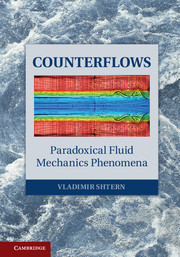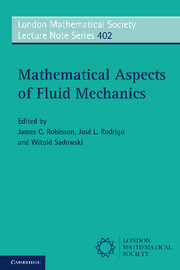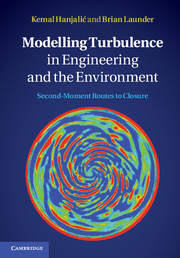3654 results in ebooks in fluid mechanics
3 - Passive Scalar Transport in Turbulence: A Computational Perspective
-
-
- Book:
- Ten Chapters in Turbulence
- Published online:
- 05 February 2013
- Print publication:
- 06 December 2012, pp 87-131
-
- Chapter
- Export citation
Preface
-
- Book:
- Ten Chapters in Turbulence
- Published online:
- 05 February 2013
- Print publication:
- 06 December 2012, pp ix-x
-
- Chapter
- Export citation
Contents
-
- Book:
- Ten Chapters in Turbulence
- Published online:
- 05 February 2013
- Print publication:
- 06 December 2012, pp v-viii
-
- Chapter
- Export citation
10 - How Similar is Quantum Turbulence to Classical Turbulence?
-
-
- Book:
- Ten Chapters in Turbulence
- Published online:
- 05 February 2013
- Print publication:
- 06 December 2012, pp 405-437
-
- Chapter
- Export citation

Counterflows
- Paradoxical Fluid Mechanics Phenomena
-
- Published online:
- 05 November 2012
- Print publication:
- 15 October 2012

Mathematical Aspects of Fluid Mechanics
-
- Published online:
- 05 November 2012
- Print publication:
- 18 October 2012

Modelling Turbulence in Engineering and the Environment
- Second-Moment Routes to Closure
-
- Published online:
- 05 November 2012
- Print publication:
- 20 October 2011
Frontmatter
-
- Book:
- Mathematical Aspects of Fluid Mechanics
- Published online:
- 05 November 2012
- Print publication:
- 18 October 2012, pp i-vi
-
- Chapter
- Export citation
9 - Stretching and folding diagnostics in solutions three-dimensional Euler and Navier–Stokes equations
-
-
- Book:
- Mathematical Aspects of Fluid Mechanics
- Published online:
- 05 November 2012
- Print publication:
- 18 October 2012, pp 201-220
-
- Chapter
- Export citation
List of Contributors
-
- Book:
- Mathematical Aspects of Fluid Mechanics
- Published online:
- 05 November 2012
- Print publication:
- 18 October 2012, pp xi-xvi
-
- Chapter
- Export citation
Preface
-
-
- Book:
- Mathematical Aspects of Fluid Mechanics
- Published online:
- 05 November 2012
- Print publication:
- 18 October 2012, pp ix-x
-
- Chapter
- Export citation
12 - Leray–Hopf solutions to Navier–Stokes equations with weakly converging initial data
-
-
- Book:
- Mathematical Aspects of Fluid Mechanics
- Published online:
- 05 November 2012
- Print publication:
- 18 October 2012, pp 251-258
-
- Chapter
- Export citation
6 - Sharp and almost-sharp fronts for the SQG equation
-
-
- Book:
- Mathematical Aspects of Fluid Mechanics
- Published online:
- 05 November 2012
- Print publication:
- 18 October 2012, pp 116-129
-
- Chapter
- Export citation
5 - A naive parametrization for the vortex-sheet problem
-
-
- Book:
- Mathematical Aspects of Fluid Mechanics
- Published online:
- 05 November 2012
- Print publication:
- 18 October 2012, pp 88-115
-
- Chapter
- Export citation
8 - Interacting vortex pairs in inviscid and viscous planar flows
-
-
- Book:
- Mathematical Aspects of Fluid Mechanics
- Published online:
- 05 November 2012
- Print publication:
- 18 October 2012, pp 173-200
-
- Chapter
- Export citation
11 - On the decay of solutions of the Navier–Stokes system with potential forces
-
-
- Book:
- Mathematical Aspects of Fluid Mechanics
- Published online:
- 05 November 2012
- Print publication:
- 18 October 2012, pp 235-250
-
- Chapter
- Export citation
4 - Remarks on complex fluid models
-
-
- Book:
- Mathematical Aspects of Fluid Mechanics
- Published online:
- 05 November 2012
- Print publication:
- 18 October 2012, pp 70-87
-
- Chapter
- Export citation
3 - A continuous model for turbulent energy cascade
-
-
- Book:
- Mathematical Aspects of Fluid Mechanics
- Published online:
- 05 November 2012
- Print publication:
- 18 October 2012, pp 52-69
-
- Chapter
- Export citation
1 - Towards fluid equations by approximate deconvolution models
-
-
- Book:
- Mathematical Aspects of Fluid Mechanics
- Published online:
- 05 November 2012
- Print publication:
- 18 October 2012, pp 1-22
-
- Chapter
- Export citation
10 - Exploring symmetry plane conditions in numerical Euler solutions
-
-
- Book:
- Mathematical Aspects of Fluid Mechanics
- Published online:
- 05 November 2012
- Print publication:
- 18 October 2012, pp 221-234
-
- Chapter
- Export citation
